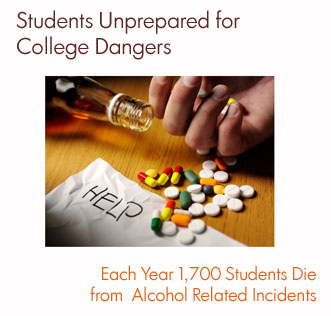
The image of a young person, eighteen or so years old, heading off to college is one filled with hope and dreams of accomplishments and future careers. Parents look at their child going off to college with pride, but if they are wise, they also feel apprehension. Now more than ever, the college experience places dangerous pitfalls into every young person’s path. And most young people going off for higher education are sadly unprepared.
First Pitfall: Heavy Alcohol Consumption
Fraternity and sorority row are known for their alcohol consumption but binge drinking is hardly restricted to those zones. According to the National Center on Addiction and Substance Abuse, half of all full-time college students binge drink, abuse prescription drugs or abuse illegal drugs. Sixty-eight percent of students drink some alcohol and four out of ten binge drink. Binge drinking frequency is way up as well.
Every year, more than 1,700 students lose their lives in alcohol-related incidents. Some students just go into a coma and never wake up and some die in traffic accidents. It is just as easy for people to need alcohol abuse rehab in college as at any other point in life.
Second pitfall: Prescription drug abuse
Abuse of prescription drugs has been skyrocketing around campuses. At first it was painkillers, tranquilizers and sedatives. In other words, Vicodin, OxyContin, Xanax and Nembutal.
Now stimulants like Ritalin and Adderall are popular drugs on campuses. These are the drugs prescribed to teens and younger children for difficulties in the classroom that some people think need drugging. Ritalin’s main ingredient is called methylphenidate and Adderall is dextroamphetamine. They are strong stimulants, similar to what is sold illicitly to get people high and addicted. Adderall college use can start addiction to this drug early in life.
Third pitfall: Marijuana abuse
A third of college students abuse marijuana, according to the annual survey Monitoring the Future. There are some signs that use may be set to increase. Numbers are already increasing among high school students.
College students who use marijuana tend to engage in other high risk behaviors, like risky sex and mixing alcohol with marijuana or combining other drugs. Students using marijuana also spend more time at parties and less time studying, and tend to have poorer academic performance.
It is not anyone’s plan that a young person graduate from college only to need alcohol abuse rehab or drug rehab to recover from four years of substance abuse. But it can easily happen that a person may need to take a break from higher education for alcohol abuse rehab treatment.
Narconon Programs Help the Recovery of Students as Well as Moms, Professionals and Artists
Narconon drug rehab programs are located around the world on six continents. They have been returning people to sober lives for more than forty-five years. Narconon objectives include helping people detoxify from drug or alcohol use that has left toxic residues in the body, and teaching each person the life skills needed to stay sober in the future.

Drug toxins tend to lodge in the fatty tissues of the body and can remain there for many years unless the right combination of time in a sauna, generous nutritional support, moderate exercise and careful supervision are provided. This is the Narconon New Life Detoxification Program, part of the overall rehabilitation service offered by Narconon centers around the world. Facilities are located in Russia, Italy, Taiwan and England, and in the US, Narconon Georgia services the Atlanta area and Narconon Vista Bay helps those in Northern California, in addition to many other US centers.
Call the Narconon alcohol program to get help with alcohol abuse. Our counselors are ready to assist you.
Resources:
http://www.casacolumbia.org/templates/publications_reports.aspx: National Survey of American Attitudes on Substance Abuse
http://www.higheredcenter.org/files/product/marijuana.pdf
http://www.monitoringthefuture.org/pubs/monographs/mtf-vol2_2010.pdf